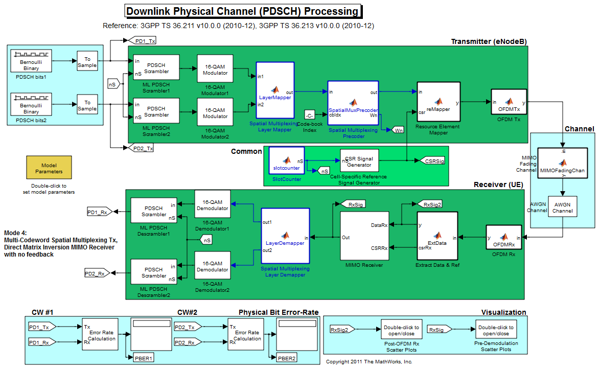LTE Downlink Physical Channel Processing
Idin's pick for this week is LTE Downlink Physical Channel processing byAmit Kansal.
Note: If you have MATLAB R2012b or newer installed, you can access thelatest versionof this model as one of the examples in theLTE Toolbox. The original files on the File Exchange have been migrated into the product.
Amit is one of our developers on theCommunications Toolbox. This submission on the File Exchange is the result of a few months' work to go throughLTE standard documents, and to implement a portion of it accurately in MATLAB/Simulink. Amit's model simulates the physical downlink shared channel (PDSCH); that is the data channel from the base-station (eNode B) to the mobile user equipment (UE). It implements transmission mode 4 (TM4) of the LTE standard (out of a possible 9 transmission modes specified in 3GPP TS 36 211 v10, 2010-12).

Why LTE?
"4G" (fourth generation) and "LTE" are all the rage these days with wireless service providers, and for good reason. Download speeds on LTE networks are approaching home DSL service levels, with the promise of even greater speeds withLTE-Advanced(100+ Mbps for high mobility users, and 1+ Gbps for low mobility). But these speeds come at a price. It takes a very complex system to deliver 100 Mbps to someone traveling at 120km/h (75mph), and LTE uses the combination of a few sophisticated technologies to achieve this.
First, the available bandwidth per user is increased from 5MHz in 3G systems to 20MHz in LTE, and up to 100MHz in LTE-Advanced. But that's not enough to get us to our desired data rates. LTE also uses multiple antenna (MIMO) systems to increase channel capacity, and increases bandwidth efficiency by usingOFDMas an interface. To provide "error free" communications across wireless links, we employerror correcting codes;turbo codesare the codes of choice for LTE.
The model in this submission includes all of these critical components: turbo coding, OFDM modulation, and MIMO channels. It implements 2x2 and 4x4 MIMO transmission modes (i.e. 2 transmit, 2 receive, or 4 transmit, 4 receive antennas). When using the model, you can select different modes of operation using the "Model Parameters" block at the top level (the yellow block in the figure above).
This example should provide a nice guide to anyone looking to implement similar models in Simulink: LTE, WiMAX, or generally any modern OFDM-based communication system. The model can also be used a base for doing further development. Some additions to this model could include support for adaptive modulation rates, carrier aggregation, and multi-user simulations.
As always, yourcommentshere are greatly appreciated.
- Category:
- Picks














 克里夫的角落:克里夫硅藻土在数学和Computing
克里夫的角落:克里夫硅藻土在数学和Computing The MATLAB Blog
The MATLAB Blog Steve on Image Processing with MATLAB
Steve on Image Processing with MATLAB Guy on Simulink
Guy on Simulink Artificial Intelligence
Artificial Intelligence Developer Zone
Developer Zone Stuart’s MATLAB Videos
Stuart’s MATLAB Videos Behind the Headlines
Behind the Headlines File Exchange Pick of the Week
File Exchange Pick of the Week Hans on IoT
Hans on IoT Student Lounge
Student Lounge MATLAB Community
MATLAB Community MATLAB ユーザーコミュニティー
MATLAB ユーザーコミュニティー Startups, Accelerators, & Entrepreneurs
Startups, Accelerators, & Entrepreneurs Autonomous Systems
Autonomous Systems







Comments
To leave a comment, please clickhereto sign in to your MathWorks Account or create a new one.